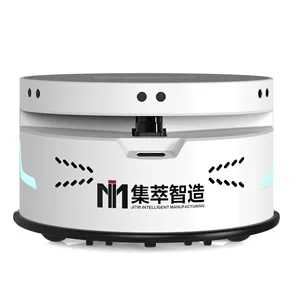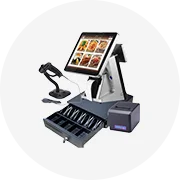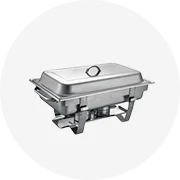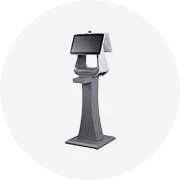What is Advanced Mobile Robotics Platform
Advanced Mobile Robotics Platforms are sophisticated systems designed to provide a comprehensive solution for researchers, engineers, and developers working in the field of robotics and automation. These platforms integrate various technologies such as sensors, actuators, computing devices, and software frameworks that enable the development and deployment of intelligent robotic systems. They are intended for users who require a versatile and robust platform to conduct experiments, test new algorithms, and implement real-world applications.
The platform's principles are rooted in creating a controlled environment where complex tasks can be executed with precision and repeatability. This is achieved through the platform's modular design, which allows users to easily customize and extend its capabilities by integrating additional sensors, cameras, or robotic arms. High-performance computing elements and sophisticated algorithms ensure that the platform can handle the computational demands of advanced robotics tasks.
These platforms are not just for researchers; they also serve as tools for high-tech industries, educational institutions, and commercial developers who wish to incorporate mobile robotics into their operations. From autonomous navigation in warehouses to remote-controlled inspection of hazardous environments, Advanced Mobile Robotics Platforms offer a versatile and reliable foundation for the implementation of robotic systems in the 21st century.
Types of Advanced Mobile Robotics Platform
Advanced Mobile Robotics Platforms come in various forms to cater to different industrial requirements and operational environments. Here are some of the types available:
-
Autonomous Guided Vehicles (AGVs): AGVs are mobile robots that transport materials across factory floors or warehouse spaces without human intervention. They follow markers or wires on the floor or use vision or lasers for navigation. AGVs are ideal for repetitive tasks like moving products from storage to packing areas in a straight line.
-
Autonomous Mobile Robots with Full Navigation and Mapping Capabilities: These robots use advanced sensors and mapping technology to navigate complex environments. They create detailed maps of their surroundings and can adapt their path in real-time to avoid obstacles and reach their destination efficiently. This is crucial for tasks such as picking items in a warehouse or navigating through busy commercial spaces.
-
Robotic Arms Mounted on Mobile Platforms: Some robots are equipped with robotic arms that provide dexterity and precision. These are often used in assembly processes or where tasks require high levels of accuracy, such as in electronics manufacturing or laboratory settings.
-
Heavy-Duty Mobile Robots for Industrial Applications: Built for demanding tasks in industrial settings, these robots can carry heavy loads or operate for extended periods without maintenance. They are commonly found in sectors like mining or heavy manufacturing for tasks such as transporting raw materials or finished products.
-
Mobile Robots for Public Spaces: These include guide robots in public venues like malls or airports that assist visitors with directions or information. They may also provide services such as cleaning or information dissemination.
How to choose Advanced Mobile Robotics Platform
Selecting the right advanced mobile robotics platform for your business involves careful consideration of several factors that align with your operational needs and strategic objectives. Here are some key points to keep in mind:
-
Intended Application: The specific tasks your robot will perform will heavily influence your choice. Whether it's for industrial material handling, retail inventory management, or agriculture, ensure that the platform has the necessary mobility and payload capacity.
-
Scalability: Consider how the platform will integrate with your current systems and whether it can support future growth. A scalable platform can adapt to increasing demands without significant additional investments.
-
Customization: Given that businesses have unique requirements, check if the platform allows for customization through software updates or additional hardware integration.
-
Support and Maintenance: Ensure that you will have access to comprehensive after-sales support including maintenance services, especially if you're operating critical or complex systems.
-
Technology Readiness: Consider if the platform incorporates advanced technologies such as AI, computer vision, or IoT that could enhance its performance and compatibility with other smart factory components.
About Advanced Mobile Robotics Platform on Alibaba.com
Alibaba.com stands out as a global wholesale marketplace that brings together an extensive array of Advanced Mobile Robotics Platforms suited for various industries and applications. With suppliers from different regions offering an assortment of platforms tailored for tasks ranging from material handling to sophisticated autonomous operations, Alibaba.com provides businesses with access to cutting-edge technology that meets their specific needs.
The platform's user-friendly interface allows businesses to filter through options based on key specifications such as industry focus, core components, application areas, functions, and even local service locations. This level of customization ensures that no matter what industry you're in—whether it be manufacturing plants or retail shops—you'll find a product that fits your requirements perfectly.
Moreover, Alibaba.com's commitment to facilitating secure transactions through services like Trade Assurance means that businesses can shop with confidence knowing that their orders will be protected until delivery is completed. This emphasis on quality assurance underscores Alibaba's focus on serving its customers with reliable trade solutions that empower businesses to enhance their operations through advanced mobile robot platforms.
Common FAQs for Advanced Mobile Robotics Platform
What is an Advanced Mobile Robotics Platform?
An Advanced Mobile Robotics Platform (AMR Platform) is a system of hardware and software designed to automate the movement and operation of mobile robots in various industrial and commercial applications. These platforms use a variety of technologies including AI, SLAM, and wireless communication to navigate and perform tasks autonomously.
How do AMR Platforms work?
AMR Platforms operate through a combination of sensors, cameras, and mapping technologies to navigate and move within a defined area. They use different methods such as LiDAR, RFID, or ultrasonic to understand their environment and make decisions about movement and tasks autonomously.
What industries commonly use AMR Platforms?
AMR Platforms are commonly used in industries that require repetitive or manual tasks, such as manufacturing plants, distribution centers, e-commerce fulfillment centers, and hospitality sectors. They are also utilized in settings like hospitals, schools, and shopping malls.
How do I determine the right type of AMR Platform for my business?
To determine the right type of AMR Platform for your business, you should evaluate the specific automation needs of your operations, the environment in which the robot will operate, any industry-specific requirements, and the after-sales services offered by the supplier.
Are there different sizes of AMR Platforms available?
Yes, AMR Platforms come in various sizes, from small robots that can fit through standard doorways to larger models suitable for warehouses and other large-scale applications. The size you choose will depend on the tasks the robot will perform and the size of the area it needs to cover.
Can AMR Platforms operate in outdoor environments?
Some AMR Platforms are designed for outdoor use and are equipped to handle various surfaces and conditions. When selecting one for outdoor operation, ensure that it is designed for such use and has features like all-terrain wheels if necessary.
What kind of after-sales support is available for AMR Platforms?
After-sales support options for AMR Platforms can include online support, video technical support, and field maintenance and repair services. The choice of support will depend on the supplier's offerings and your business's specific needs.
How do I ensure the AMR Platform meets safety standards?
To ensure that an AMR Platform meets safety standards, look for products that have been tested and certified by recognized organizations. Compliance with global safety standards such as CE or UL ensures that the robot has been evaluated for safety and performance.
How does an AMR Platform handle changes in its environment?
AMR Platforms use sensors and mapping technologies to adapt to changes in their environment. For instance, they may use LiDAR or cameras to detect obstacles or changes in their programmed map and adjust their route accordingly.
Is it possible to customize an AMR Platform to fit unique business requirements?
Many suppliers offer customization options for their AMR Platforms. These can include custom software interfaces, onboard equipment additions, or tailored design modifications to meet unique business needs.
What materials are used in the construction of AMR Platforms?
AMR Platforms are often constructed using durable materials such as steel, aluminum alloy, or other metals. The choice of material may impact the weight, cost, and longevity of the robot.
How do I determine if an AMR Platform is capable of handling the tasks I require?
To determine if an AMR Platform is capable of handling the tasks you require, review the specifications provided by the supplier, inquire about the technology used (such as AI or SLAM), and check if similar systems have been successfully implemented in comparable settings.
What kind of power sources are used in AMR Platforms?
AMR Platforms can be powered by various sources including electric motors, batteries, or direct connections to power systems. The power source should be selected based on the intended use and location of the robot.






































 浙公网安备 33010002000092号
浙公网安备 33010002000092号 浙B2-20120091-4
浙B2-20120091-4